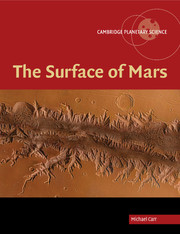9 - Wind
Published online by Cambridge University Press: 12 August 2009
Summary
Wind is one of the few geological agents for change that has been seen in action at the martian surface. Local and global dust storms have been observed to wax and wane. Dust devils have been observed both on the ground and from orbit. Changes in the configuration of wind-created albedo patterns have been followed from year to year, and disturbances of loose debris at the surface have been noted both from orbit and on the ground. In addition, almost all high-resolution images taken from orbit show ripple-like features and dunes, clear evidence of pervasive wind activity. Yet it appears that the efficacy of wind in modifying the landscape is limited. The wind mostly redistributes loose or poorly cohesive material across the surface. Wind erosion of primary volcanic and impact terrains is mostly minor. The only parts of the surface that are significantly eroded by the wind are where poorly coherent, layered sedimentary rocks are present.
The cycling of fragmental debris that can be moved by the wind is very different on Earth and Mars. On Earth most of the rock debris of a size most easily moved by the wind is quartz sand, most of it originally derived by the mechanical and chemical breakdown of granitic rocks. The sand spends only a geologically short time on the land surface participating in eolian processes before it is transported to the oceans where it is buried and ultimately lithified and incorporated into the sedimentary rock record.
- Type
- Chapter
- Information
- The Surface of Mars , pp. 193 - 210Publisher: Cambridge University PressPrint publication year: 2007



